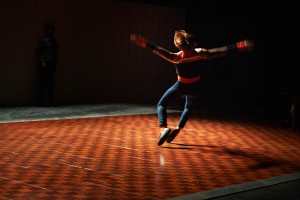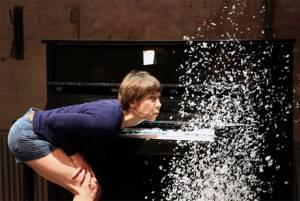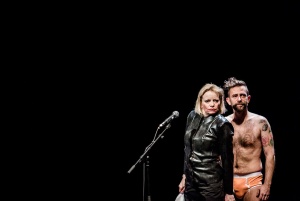Conceiving and creating a new work is like capturing the detailed minutiae of a dream, except it’s in the future… I don’t think we surrender ourselves to the wild plains of our imagination enough. Art is about creating an elemental experience of life, which the audience is invited to participate in along with the performers.
Within modul-dance, I’ve had research modules at Art Station Foundation in Poznań, Poland and at Plesna Izba in Maribor, Slovenia; and residencies in CSC Bassano del Grappa, Italy and CDC Toulouse in France.
In Poland, in March 2013, I spent half of my time in Poznań, writing, working alone in the studio, chatting to other artists and spending time with an enthusiastic ethnography student from Adam Mickiewicz University, listening to polish lore and folk stories; and the second half in Warsaw, dwarfed by the wind-chilled, wide grey boulevards, and felt the constant shadow of Stalin’s Palace of Science and Culture, absorbing the vibrations (and -8 degrees celsius temperatures) of this multi war surviving “phoenix city”.
In May I travelled to Bassano del Grappa, where I worked alone for the first 5 days of the residency, which I often find difficult to do, particularly as I don't usually choreograph for my own body.
I spent a lot of time reading and writing, and being in another place without the everyday burdens, really helped. Roberto arranged a trip up the mountains for me, led by a young academic fountain of knowledge, Sebastiano Crestani, to see some ancient etchings. Unfortunately the Alpine rain cancelled our hike, and instead we went to Padua, where I saw an exhibition on the ancient Veneti people and an amazing 6 mt wooden horse made in 1466.
For the second week I invited Justine Cooper to join me, a performer with whom I already developed some ideas. We shared some ideas with a wonderfully engaged and generous audience there before we left. We also got to sit in on a rehearsal of an all male choir, singing old Italian and Alpine folk songs, a real treat to watch a committed group of mean aged 30-80 singing like angels!
My 4 day trip to Maribor (Plesna Izba) in June was planned to coincide with the annual FolkArt Festival, which is a bit like the dance version of Eurovision in it’s presentational format. Mojca had arranged front row seats for the 3 nights, and I sat there, blown away by these massive ensembles of predominantly amateur dancers (some pretty hefty guys) doing amazingly complex things, passionate about preserving their national dances. I got a private lesson from Vaska, a Slovenian dance historian, choreographer and choreologist of folk dances from the regions. It was here in Maribor where my attention began to focus more towards the crazy music of the Balkans.
My final 2-week residency took place in Toulouse in December 2013, and this time I brought along 5 dancers. It was the first time for us all to be together, and we spent the entire 2 weeks working in the studio. The facilities at the CDC were wonderful, in that we spent most of the time dancing, eating and talking, which resulted in a sense of ease in our environment and explorations. This ease allowed me to go places artistically I’d never been before. Newer, darker, funnier, stranger places. We had some visits from school children who sometimes joined in the warm ups and university students with whom we shared and discussed small segments of our work.
With Tundra I wanted to explore a familiar concept/myth/truth, depending on one’s beliefs, to reveal the poetry of “heaven and hell” and the instability and abysses that exists within us all and in everyday life. I wanted to somehow work with the potential of an unseen world, and feeling the breath of “the ideal”, without wanting to impose any sort of didactic notions on the work. But I am drawn to thinking about reason and logic being overcome by internal and external forces. By that I’m talking about intuition and the connection between our own instinct and a greater external force outside of our control and indeed understanding. Not wanting to sound too esoteric or ethereal, Tundra is a world that’s cosmically misaligned, where time and space lose their boundaries, inhabited by characters who are confronted by fear -of themselves, their existence, their actions and of the unknown, but ultimately they want to break through those barriers to a higher plane. I’ve been thinking about the cyclical nature of time, and how, historically, we can see patterns emerging, where at certain times everything goes into a state of flux and volatility. It looks like we’re in that state right now, and it is a time of insecurity, change and we have witnessed the exposure of a huge amount of human suffering and darkness. I'm endlessly interested in talking and exploring human nature but in particular our chaos, and struggle with desire and death. I enjoy delving into seemingly banal moments, which our mind and imagination has the capacity to make extraordinarily beautiful or horrific.
I like to allow the spectator to receive his own interpretation of each moment for her/himself, and to allow the mind to organize it in it’s own way. It’s an innate process that we naturally do anyway, so it’s not that any special intellectual treatment or analysis is required. But the aim is to allow the arrangement of all of the components of our creation to have an individual effect or Gestalt in the eye of each spectator.
Each piece of work requires a specific language, a movement one, a visual one, a musical one and sometimes a spoken one. And so for me the “sequence of steps” has to take a secondary position to the people who are actually doing them. An intelligent performer requires much more to keep her/himself stimulated than just repetition. And so that’s when the work becomes much more interesting when the performers are also creators and bringing themselves to it. I was really buzzed by the performers that I worked with on Tundra, which demanded a mutual act of searching from us all. They really brought themselves, their experience, memories and, most importantly, their imaginations into the room. The characters are emerged from them, which felt more truthful, than imposing mannerisms and alien stories on them. The performers are paramount to the work- they are the ones that distil, embody and deliver the energy to the audience, and I have been very fortunate to work with some really wonderful artists.
Tundra premiered at the Dublin Dance Festival in May 2014 and was packed up after it’s successful 4 -show run. What next? There’s a new work on the way in 2015, there’ll always be a new work. But it can be exhausting always creating new work for just a handful of performances, and hoping a DVD will magically enable a longer life for it or garner interest in the next new work.
As I Iook back on my modul-dance experience, and attempt to measure the result my participation has had on the work, there are of course lots of interesting and fruitful moments that come to mind, many of which I mentioned earlier. But I also wonder about how the participating artists affect the partners and modul-dance as an organization. This remains a mystery to me. And although it was an enriching experience to develop the piece in new, unfamiliar places, the question of "what next" will not leave my mind.
Picture: © Ros Kavanagh








